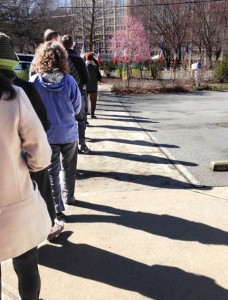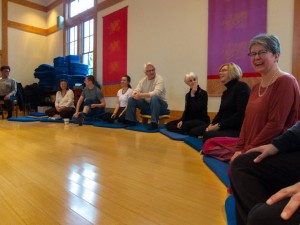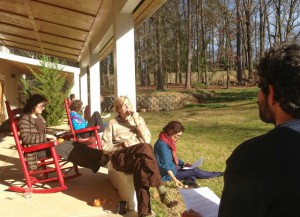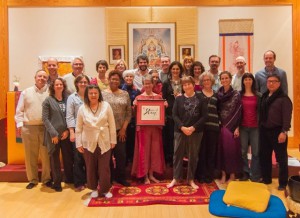Friday
Community ArticlesThe Shape of Awake
 Learning to Recognize the Bodily Cocoon,
Learning to Recognize the Bodily Cocoon,
and Letting Go of It
by Adam Sinclair
photos by Chris Luginbuhl
Each year, Hope Martin leads a week long retreat at the Shambhala Center in Atlanta. It’s a weekthun in the traditional sense of seven days of intensive meditation practice, silent meals, and a deliberate withdrawal from the stimulus of the outside world. But in addition to that, it’s a week-long examination and practice of the Alexander Technique, of which Hope is a master teacher. This is what makes it unique, and what made it such a profound experience for me, and for my fellow students.
The Alexander Technique, practiced and developed for over a century now, focuses on bodily alignment, freedom of breath, and ease of motion. It begins with the endeavor to give careful, loving attention to the ways we have come to hold our bodies over the course of our lives. Each person does this differently, though themes emerge: many of us hunch forward to shelter and protect ourselves (and to type); many of us taught to have “good posture” stick our chests out and hold ourselves rigidly in place. Unless you’ve managed to grow into adulthood without the least stress or strain, you’ve got your own pattern, and chances are it interferes with full, calm breath in everyday life.
Alexander Technique isn’t about “correcting” these patterns in order to have the “right” posture. It is, at  least as Hope Martin teaches it in concert with meditation practice, first a means to come into compassionate awareness of how deeply our habitual bodily patterns shape our habitual mental patterns. In fact, what Hope teaches, and what has made such a profound difference in my practice since I attended her retreat in Atlanta, is that the mental and bodily patterns are one in the same thing. The cocoon Chogyam Trungpa writes about isn’t just a mental cocoon. It is quite literally a physical restraint between us and the freedom of openness to the world.
least as Hope Martin teaches it in concert with meditation practice, first a means to come into compassionate awareness of how deeply our habitual bodily patterns shape our habitual mental patterns. In fact, what Hope teaches, and what has made such a profound difference in my practice since I attended her retreat in Atlanta, is that the mental and bodily patterns are one in the same thing. The cocoon Chogyam Trungpa writes about isn’t just a mental cocoon. It is quite literally a physical restraint between us and the freedom of openness to the world.
There were about thirty of us who participated, from as far away as Canada and New York and as close by as the Decatur neighborhood where the Atlanta Center is located. They have a beautifully light, spacious, and open shrine room set amongst a group of buildings on a lovingly tended, sloping bit of land where we did our outside walking meditations each day. The week is an urban retreat, which is to say that all but a few of us left the center each night to stay with friends or other Sangha members who were hosting participants for the week. This comes with the daily practice of moving between the quiet container of the retreat and the outside world, but it’s all arranged in such a way by the staff and volunteers that made it feel quite seamless.
 On the first Sunday, Hope introduced us to the basics of Alexander Technique and then, throughout the week, we learned more about it through her afternoon teachings. But the retreat and her approach is about far more than abstract knowledge. Perhaps the single most valuable and transformative aspect of the experience for me and many others was the hands-on work Hope did with each of us every day as we meditated.
On the first Sunday, Hope introduced us to the basics of Alexander Technique and then, throughout the week, we learned more about it through her afternoon teachings. But the retreat and her approach is about far more than abstract knowledge. Perhaps the single most valuable and transformative aspect of the experience for me and many others was the hands-on work Hope did with each of us every day as we meditated.
For years, I’d sat on the very front of my cushion, supporting my weight partially through the contact of my knees to the floor. This led to lots of pressure and even pain in my legs but I’d decided that’s what I had to do to remain “properly” upright. With her gentle touch, and the gentle guidance of her hands, she allowed me to experience directly how this pattern was interfering with my breath.
It’s hard to describe in words how deep, and deeply awakening it was to be allowed to let go of that pattern, which it turns out was caught up with all sorts of ideas I had about being “a good meditator” and “doing it right”. I’m a too-tight meditator, not a too-loose one. I knew this intellectually, and through loving kindness practices endeavored to let myself go. Meditation is an intensely physical experience for me. I hold so much of my tension in my muscles, even when focusing on my breathing. Put simply, what the week with Hope taught me, was that the physical letting go, the unclenching, was the meditation itself. When the muscles in my neck relaxed, so did my thoughts. They didn’t disappear, of course, but they began to lose some of their tyrannical force.
For me, observing this kind of change in myself is tricky because I easily fall into being hyper-vigilant  and over reading the signals from both my mind and body. But what was amazing about this practice in a group setting was watching similar transformations take place in my fellow students. The retreat’s name is “The Shape of Awake” and it’s no exaggeration to say that I saw people awakening into their own bodies before my very eyes. To see another person let go of a habitual pattern of holding, and see the sudden ease and relief in their faces — it’s quite moving. It’s not about speech or language. It’s direct and palpable. You see it in them and you feel it in yourself.
and over reading the signals from both my mind and body. But what was amazing about this practice in a group setting was watching similar transformations take place in my fellow students. The retreat’s name is “The Shape of Awake” and it’s no exaggeration to say that I saw people awakening into their own bodies before my very eyes. To see another person let go of a habitual pattern of holding, and see the sudden ease and relief in their faces — it’s quite moving. It’s not about speech or language. It’s direct and palpable. You see it in them and you feel it in yourself.
It’s not easy work. The cocoon, after all, is a comfortable place. But never before have I felt the possibilities of leaving it behind so viscerally and immediately. That week in Atlanta has changed the way I sit for good. Naturally, I still clench and hold myself in myriad ways, on the cushion and off, but the difference between having a simple, practical means of noticing, attending, and letting go of that, and, on the other hand, just feeling that it’s a drag to be uncomfortable or in pain, is enormous. Enormous and quite liberating.
~~
Hope Martin is a meditation instructor and teacher in the Shambhala Buddhist tradition. She has taught the Alexander Technique for more than 25 years, trains teachers at the American Center for the Alexander Technique and operates Hope Martin Studio in New York City. Visit www.hopemartinstudio.com.

















Jun 1, 2013
Reply
This article so wonderfully describes my own experience of the “Shape of Awake” weekthun. We are so used to our own physical and mental habits that it is difficult to see them clearly. In the safe environment of the beautiful Atlanta center, under the gentle hands on guidance of Hope Martin, we were able to experience our own patterns, or cocoon, and feel the transformation of letting them go. Like Adam, I tend to hold myself tightly, lifting through the rib cage and arching the lower back. When I was able to let that go, I felt a corresponding emotional release which, for a split second, felt annihilating. It was a letting go of an ego based thought pattern of “who I’m supposed to be.” What followed was a sense of openness and freedom, a vulnerable yet more authentic presence. It has had a lasting impact on my meditation practice as well as my everyday life.
May 27, 2013
Reply
This sounds profound and wonderful…it would be great if Hope or another trainer in this method could give such a weekthun in the Northwest.
May 24, 2013
Reply
Sounds very good. Yet another example of how body and mind aren’t truly seperate.